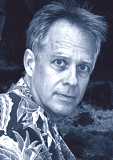He has taught lessons on altered states and psychobiology in Stanford University, the same school were he previously got a Ph.D. in Psychophysiology.
In 1987, he founded The Lucidity Institute which promotes research on topics related to lucid dreaming.
"Conscious Mind, Sleeping Brain"
LaBerge designed a device that facilitates the access to lucid dream states. It consists on a special kind of mask, that every time it detects that the user is entering into an REM cycle, sends flashlights directly to his eyes. The idea is that our brain, although asleep, receives a luminous signal that lets us know whenever we start a dream phase. This way you can consciously recognize your dreaming state and control your activities during it. The device is known as DreamLight.
Through the profound and rigorous study of oneirology, LaBerge has come to conclusions that go beyond the traditional perspective of science. He is recognized for being the first scientist to prove the phenomena of lucid dreaming, following an empirical method and being properly demonstrated.
“The basic idea of proving lucid dreaming was a simple one. It was based on earlier studies that showed that, if a person in their dream happened to be watching a ping-pong game and they’re looking from left to right, the eyes of their sleeping body would show a corresponding pattern of eye-movement activity. So I had thought that, since in a lucid dream I can volitionally do whatever I want, why not make a signal that we could agree upon in advance; a pattern of eye-movement signals that could then be used to prove that I had a lucid dream and that I knew I was dreaming while I was in the dream? We could also use that to establish what stage of sleep lucid dreaming occurred. I thought it would be REM sleep just because that was when most dreaming occurs.”
His work invites us to take a conscious responsibility for our dreams, transforming ourselves in a rational reflection of Chuang Tzu´s butterfly.
“The most important kind of sleep-learning that you can do is not having a tape-recording and trying to pipe more factual information into you. Sleep time is not a very good time for taking in information, but lucid dreams are an excellent opportunity for experiential learning, for finding out about the wisdom of life. Having an encounter with a dragon, for example, which you won’t ever have the opportunity for in the waking state. You have to have the courage to resist the fear that you’ll actually feel, to say this dragon is a mental image - a mental image can’t hurt me, and then to act on that. I would advise having a conversation, making friends with the dragon. The point is, is that what you can learn from your experiences in the lucid dream state are things that can apply to your waking state.”
The Lucidity Institute --- http://www.lucidity.com/
Awake the mirror:
enjoy the parade --- invoke lucid highways for all our dreams…


1 comment:
Have you ever dreamt you are living someon elses dream?
A whole new reality is out there. FOr centuries the human mind has been trying to decypher it...
Making friends with the dragon sounds like the best thing to do...
Will definetly try!
Post a Comment